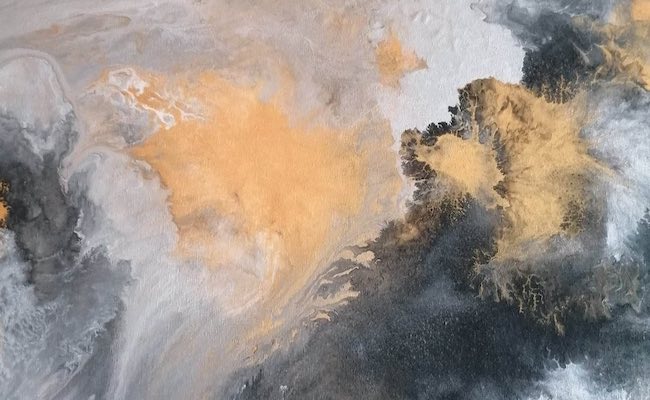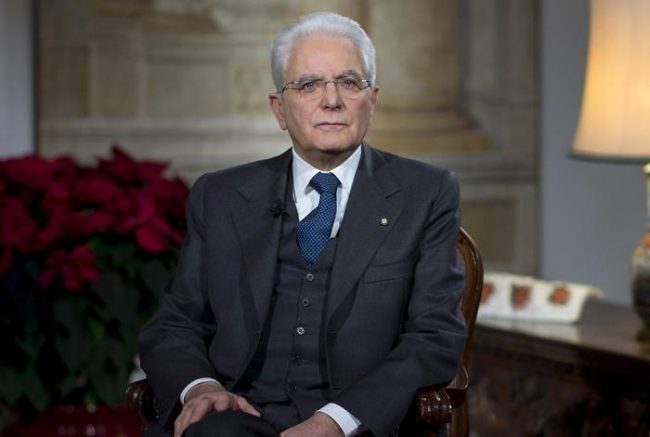Raccontare tutto ciò che si nasconde dentro l’animo è stato un punto focale di quella generazione di artisti del secolo scorso che non riusciva a concepire il gesto pittorico come qualcosa di distaccato o estraneo al sentire, all’individualità dell’esecutore dell’opera che si trasformava così in voce interpretativa delle emozioni attraverso un linguaggio stilistico affine alla libertà espressiva di cui l’interiorità necessitava. Nella contemporaneità si delinea la medesima esigenza di approfondimento anche se forse persino più esistenzialista, attraverso una ricerca intima e necessitante di trovare all’esterno spiegazioni che l’individuo non riesce a trovare in se stesso. La protagonista di oggi sceglie uno stile istintivo, irrazionale proprio per cercare di lasciar fuoriuscire le proprie sensazioni e, in virtù del gesto pittorico, portarle a un livello più consapevole.
La necessità di trovare un linguaggio che potesse lasciare spazio e assecondarsi alla nuova esigenza di alcuni artisti di mediare tra la tendenza all’indefinitezza della forma e l’impulso a comunicare tutto ciò che diversamente sarebbe rimasto in silenzio, che fosse una sintesi tra la freddezza dell’Astrattismo e un Espressionismo ancora troppo legato alla figurazione, all’immagine seppur resa meno reale e più assoggettata al sentire rispetto all’arte più accademica, si manifestò intorno alla metà degli anni Cinquanta del Novecento attraverso l’Espressionismo Astratto. Questo movimento artistico si pose come connessione tra uno stile informale in cui le sensazioni potessero trovare il modo di comunicare senza alcuna regola stilistica, e la vivacità cromatica funzionale a interpretare proprio le profondità che in virtù dell’approccio istintivo e dell’immediatezza dell’atto pittorico si concretizzavano sulla tela; in qualche modo in quegli anni c’erano tormenti da oltrepassare, molti degli appartenenti al movimento erano dovuti emigrare negli Stati Uniti durante la seconda guerra mondiale per sfuggire alle persecuzioni, paure e sensazioni a cui far trovare una valvola di sfogo, oppure semplicemente emozioni da raccontare a volte persino in maniera soffice e morbida, sulla base della natura espressiva di ciascun appartenente al gruppo. Helen Frankenthaler fu forse la più poetica, positiva, delicata nelle sue opere con contrasti cromatici sfumati e fatti di tonalità pastello, dando un’interpretazione completamente inedita e personale del Color Field; anche CyTwombly narrò un mondo lirico, costituito da tonalità delicate e impalpabili, da fiori indefiniti che avvolgono l’osservatore trascinandolo nel suo universo sognante e idilliaco. Di contro però l’irruenza pittorica emergente dalle grandi macchie di colore intenso e in contrasto tra loro di Clyfford Still evidenziava un tipo di gesto plastico decisamente più liberatorio, più concentrato a determinare un’esplosione che solo dopo la seconda fase, quella dell’osservazione, poteva raggiungere il significato finale; tanto quanto i grovigli cromatici di Joan Mitchell sembravano narrare la confusione interiore, l’accumularsi di emozioni irrazionali e di fatto stratificate fino al momento del loro concretizzarsi confusamente sulla tela. Dunque l’Espressionismo Astratto divenne non solo la fusione tra due stili in precedenza nettamente separati bensì anche il sinonimo di completa libertà creativa ed espressiva, purché nelle tele fosse percepibile la personalità e la soggettività dell’autore dell’opera che poi inevitabilmente investiva e comunicava con il fruitore.
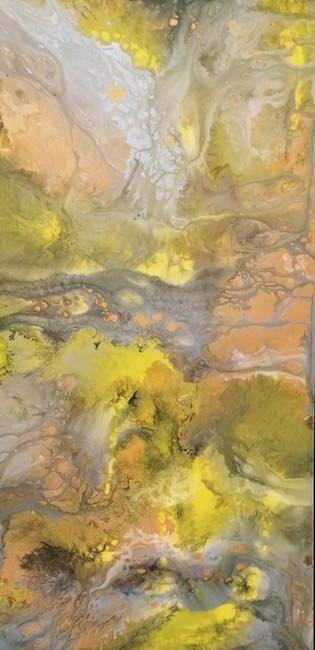
L’artista di origini russe ma ormai da molti anni residente in Germania Irina Befa, accoglie e personalizza l’eredità dei maestri dell’Espressionismo Astratto perché le vicende personali e il suo punto di osservazione su tutto ciò che accade intorno a lei la inducono a trovare uno stile che le consente di parlare senza dire, di liberare tutto ciò che diversamente sarebbe trattenuto senza però che il suo messaggio condizioni chi guarda le sue opere, perché in fondo il suo desiderio è quello di creare emozione, connessione attraverso la sua capacità di far vibrare le corde interiori che si sintonizzano sulla frequenza dell’anima; esprimersi attraverso un linguaggio figurativo significherebbe costringere il fruitore ad avvicinarsi all’opera attivando quei ricettori razionali che lo distaccherebbero automaticamente dal coinvolgimento dei sensi, dell’istinto che induce a sentirsi vicini senza di fatto comprendere il perché.
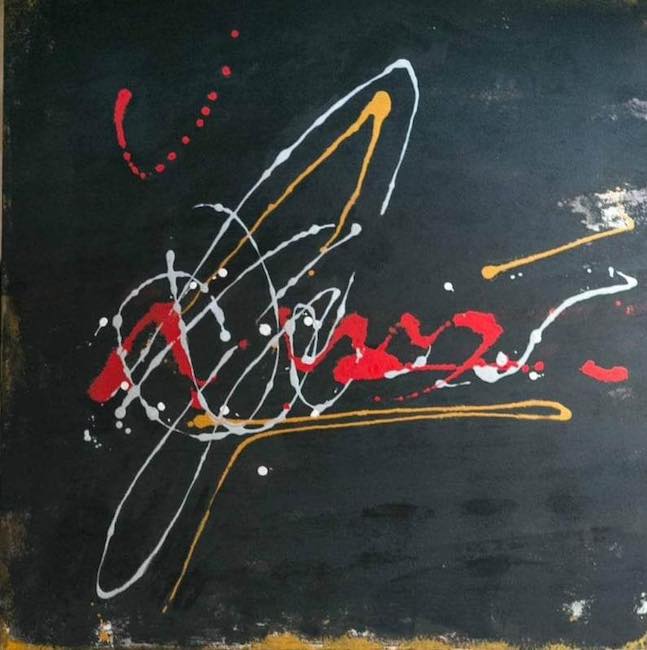
Irina Befa si immerge letteralmente nel suo mondo interiore, esplora e poi esterna tutto ciò su cui riflette, su cui medita o semplicemente che appartiene a una spontaneità del sentire spesso incapace di essere arginata, o spiegata, dalla logica e dunque l’unico modo per lasciare che emerga alla luce della consapevolezza è accettarla, accoglierla e poi permetterle di parlare un linguaggio proprio, quello governato dall’impetuosità e dall’urgenza di far sgorgare all’esterno di sé le percezioni istintive.
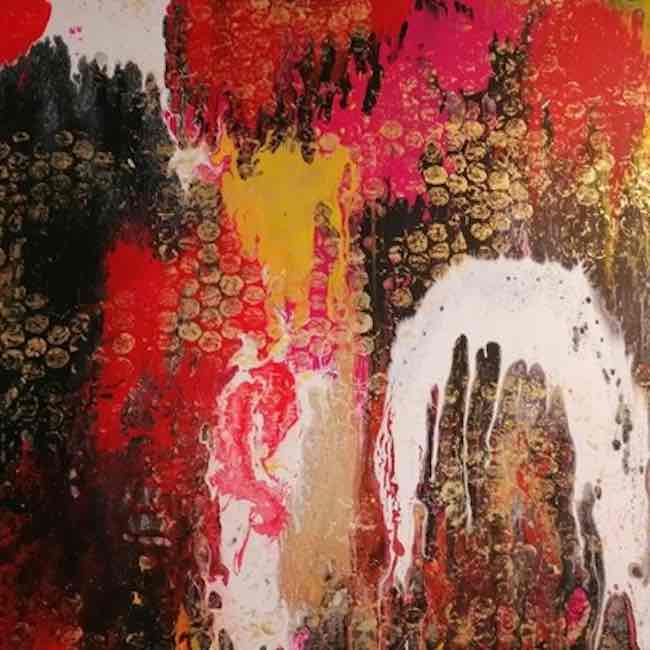
A volte la sfera di interesse e di osservazione di Irina Befa si rivolge alla natura umana, al sentire, ai ricordi, al considerare un frangente unico dopo il quale tutto ha assunto un significato differente, altre invece si perde nella contemplazione affascinata dell’universo, di tutto ciò che è lontano dall’uomo pur riuscendo a influenzarne gli umori ed esercitando l’attrazione dell’inspiegabile.

L’artista attribuisce quindi ai pianeti e alle stelle un significato metaforico che coincide con lo stato d’animo dell’istante in cui si pone davanti alla tela e comincia l’azione pittorica, come nell’opera Comet dove la scia non è bianca e luminosa come nell’immaginario comune bensì la gamma cromatica scelta è sui toni dell’arancio e del rosso, come se il simbolico passaggio rapido della stella corrispondesse e fosse legato alla passione, all’intensità di un frangente indimenticabile ma poi sfuggito via perché probabilmente troppo travolgente per essere destinato a durare, e altrettanto impossibile da dimenticare. La scia pertanto non è posizionata dietro bensì all’interno della stella, come se la sensazione percepita fosse tatuata nel nucleo, inteso come cuore ed essenza, dell’incandescenza che c’era stata intorno.
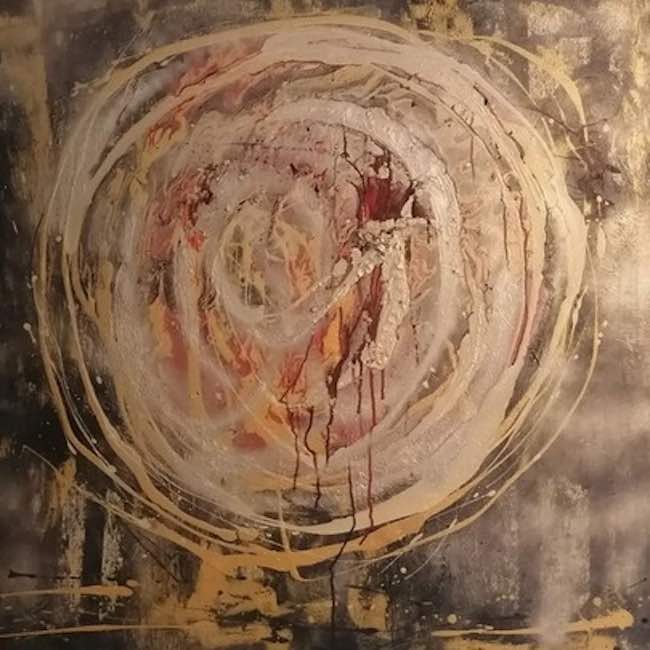
In Universum Irina Befa elimina tutta l’oscurità che abitualmente avvolge le galassie e utilizza colori tenui, sulla gradazione del beige a sottolineare l’armonia che contraddistingue i pianeti che ne fanno parte, l’inspiegabile equilibrio perfetto e contiguo appartenente a un concetto talmente ampio da essere sfuggente e dunque l’unico modo per l’individuo, e per l’artista, è quello di renderlo comprensibile attraverso il parallelismo con lo spazio più ridotto dell’interiorità umana; l’universo a questo punto è quello personale, quello intimo, in fondo l’unico davvero conoscibile sempre che ci si ponga in posizione introspettiva e di profondo ascolto di quei moti segreti troppo spesso ignorati. La sofficità delle tonalità scelte per narrare uno spazio tondeggiante sembrano essere quelle positive della morbidezza dell’animo, quel luogo sconosciuto che deve essere scoperto indagandone il mistero, molto simile in fondo a quello dell’universo lontano. L’invito dell’artista è quello di immergersi in quell’atmosfera accogliente che corrisponde all’io più nascosto e dialogare con esso per fa sì che emerga senza timore. Perché poi il lato più riflessivo e meditativo deve fuoriuscire con veemenza, e Irina Befa lo fa nelle tele dedicate alle emozioni, al percorso di conoscenza di sé che corrisponde al prendere atto dei propri errori che hanno provocato un distacco, delle paure vinte, dei dolori superati in virtù della resilienza che lei stessa ha scoperto di avere, mostrando all’osservatore quanto sia importante, e possibile, guardare al domani con atteggiamento positivo perché tutto ciò che accade oggi costituirà la forza del periodo successivo.
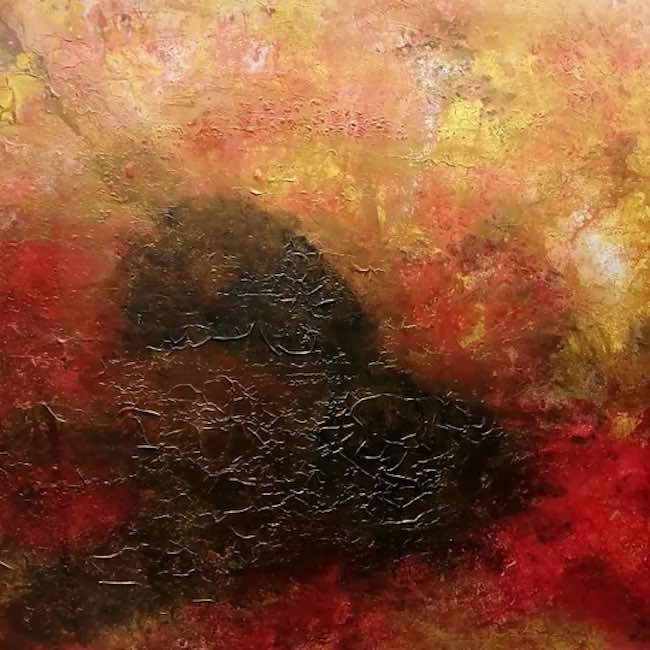
Questo è ciò che emerge dall’opera Erinnerungen (Ricordi), dove il nucleo iniziale cupo e probabilmente memoria di un dolore vissuto si lascia stemperare dall’atmosfera circostante, da quelle sfumature che tendono al rosato che sembrano essere utilizzate dalla Befa per suggerire all’osservatore, ma anche a se stessa, di volgere lo sguardo in alto, di pensare al meglio che potrà sopraggiungere piuttosto che rimanere a galleggiare in un passato che in nessun caso può essere modificato. L’interiorità dunque prende atto dell’ineluttabilità di ciò che è stato e comincia a intravedere la possibilità che le cose possano avere un risvolto differente, che gli accadimenti non definiscono un percorso semmai ne sono solo una parte, inevitabile e triste, certo, tuttavia non rappresentano l’intero cammino.

Irina Befa si è formata come autodidatta ma si è fatta notare fin dall’inizio della sua carriera grazie all’intensità comunicativa e al suo linguaggio espressivo che si avvale spesso della tecnica della Fluid Art; partecipa regolarmente a mostre collettive internazionali dove riscuote grande successo di pubblico e di critica.
IRINA BEFA-CONTATTI
Email: befaart@gmx.de
Facebook: https://www.facebook.com/profile.php?id=100015225612051
Instagram: https://www.instagram.com/befaart/
The inner turmoil of Irina Befa’s Abstract Expressionism, between restlessness and faith in the future
Telling everything that is hidden inside the soul was a focal point of that generation of artists of the last century who could not conceive of the pictorial gesture as something detached or extraneous to the feeling, to the individuality of the executor of the artwork, which was thus transformed into an interpretative voice of the emotions through a stylistic language akin to the expressive freedom that interiority needed. In the contemporary world, the same need for in-depth study is outlined, although perhaps even more existentialist, through an intimate quest to find outside explanations that the individual cannot find within himself. Today’s protagonist chooses an instinctive, irrational style precisely in order to try to let her feelings come out and, by virtue of the pictorial gesture, bring them to a more conscious level.
The need to find a language that could leave room for and accommodate the new need of some artists to mediate between the tendency to indefiniteness of form and the impulse to communicate all that would otherwise have remained silent, that was a synthesis between the coldness of Abstractionism and an Expressionism still too tied to figuration, to the image albeit made less real and more subject to feeling than more academic art, manifested itself around the mid-1950s through Abstract Expressionism. This artistic movement emerged as a connection between an informal style in which sensations could find a way to communicate without any stylistic rules, and the chromatic vividness functional to interpreting the very depths that by virtue of the instinctive approach and the immediacy of the pictorial act were realised on canvas; somehow in those years there were torments to be overcome, many of the members of the movement had had to emigrate to the United States during the Second World War to escape persecution, to find a way out for fears and feelings, or simply emotions to be recounted sometimes even in a soft and gentle manner, based on the expressive nature of each member of the group.
Helen Frankenthaler was perhaps the most poetic, positive, delicate in her works with shaded colour contrasts made of pastel shades, giving a completely new and personal interpretation of the Colour Field; CyTwombly also narrated a lyrical world, made up of delicate and impalpable shades, of undefined flowers that envelop the observer, dragging him into his dreamy and idyllic universe. On the other hand, however, the pictorial impetuosity emerging from Clyfford Still‘s large blobs of intense and contrasting colour highlighted a type of plastic gesture that was decidedly more liberating, more concentrated on determining an explosion that only after the second phase, that of observation, could reach its final meaning; just as Joan Mitchell‘s chromatic tangles seemed to narrate inner confusion, the accumulation of irrational emotions that were in fact stratified until the moment of their confused concretisation on the canvas. Thus, Abstract Expressionism became not only the fusion of two previously clearly separated styles, but also the synonym for complete creative and expressive freedom, as long as the personality and subjectivity of the author of the artwork could be perceived in the canvases, which then inevitably invested and communicated with the viewer. The artist, of Russian origin but now living in Germany for many years, Irina Befa, accepts and personalises the legacy of the masters of Abstract Expressionism because her personal events and her point of observation on everything that happens around her lead her to find a style that allows her to speak without saying, to release everything that would otherwise be held back without her message conditioning the viewer of her artworks, because at bottom her desire is to create emotion, connection through her ability to vibrate the inner chords that tune in to the frequency of the soul; expressing oneself through a figurative language would mean forcing the viewer to approach the work by activating those rational receptors that would automatically detach him from the involvement of the senses, of the instinct that induces one to feel close without actually understanding why. Irina Befa literally immerses herself in her inner world, explores and then externalizes everything that she reflects on, meditates on or simply belongs to a spontaneity of feeling that is often incapable of being contained, or explained, by logic and therefore the only way to let it emerge in the light of awareness is to accept it, welcome it and then allow it to speak its own language, the one governed by the impetuosity and urgency of letting instinctive perceptions flow out of oneself.
At times, Irina Befa‘s sphere of interest and observation turns to human nature, to feeling, to memories, to considering a unique juncture after which everything has taken on a different meaning, at others, she loses herself in the fascinated contemplation of the universe, of everything that is far from mankind yet manages to influence its moods and exerts the attraction of the inexplicable. The artist thus attributes to the planets and stars a metaphorical meaning that coincides with the state of mind of the instant in which she stands in front of the canvas and begins the pictorial action, as in the painting Comet where the trail is not white and luminous as in the common imagination but rather the chromatic range chosen is in shades of orange and red, as if the symbolic rapid passage of the star corresponded to and was linked to passion, to the intensity of a moment that was unforgettable but then slipped away because it was probably too overwhelming to last, and equally impossible to forget. The tail is therefore not positioned behind but within the star, as if the perceived sensation were tattooed in the core, intended as heart and essence, of the incandescence that had been around it. In Universum, Irina Befa eliminates all the darkness that usually surrounds galaxies and uses soft colours, in shades of beige, to emphasise the harmony that distinguishes the planets that are part of it, the inexplicable perfect and contiguous equilibrium belonging to a concept so vast as to be elusive, and therefore the only way for the individual, and for the artist, is to make it comprehensible through parallelism with the smaller space of human interiority; the universe at this point is the personal, the intimate one, after all the only one that is truly knowable, provided that we place ourselves in a position of introspection and deep listening to those secret motions that are too often ignored. The softness of the tones chosen to narrate a rounded space seem to be the positive ones of the softness of the soul, that unknown place that must be discovered by investigating its mystery, very similar at bottom to that of the distant universe.
The artist’s invitation is to immerse oneself in that cosy atmosphere that corresponds to the most hidden self and dialogue with it so that it emerges without fear. Because then the more reflective and meditative side must vehemently come out, and Irina Befa does so in the canvases dedicated to emotions, to the path of self-knowledge that corresponds to taking note of one’s mistakes that have caused a detachment, of fears overcome, of pains won by virtue of the resilience that she herself has discovered to have, showing the observer how important it is, and how possible, to look to tomorrow with a positive attitude because everything that happens today will constitute the strength of the period that follows. This is what emerges from the painting Erinnerungen (Memories), where the initial sombre core and probably memory of an experienced pain is diluted by the surrounding atmosphere, by those shades tending to pinkish that seem to be used by Befa to suggest to the observer, but also to herself, to look upwards, to think of the best that may come rather than to remain floating in a past that in no way can be changed. Inwardness therefore takes note of the inevitability of what has been and begins to glimpse the possibility that things may have a different turn, that events do not define a path, if anything they are only a part of it, inevitable and sad, of course, but they do not represent the whole path. Irina Befa trained as a self-taught artist but has made a name for herself since the beginning of her career thanks to her communicative intensity and her expressive language, which often makes use of the Fluid Art technique; she regularly participates in international group exhibitions where she has a great success with the public and critics.


